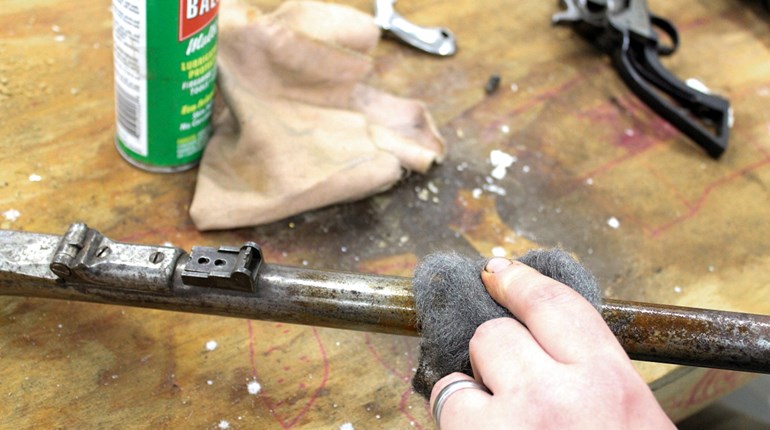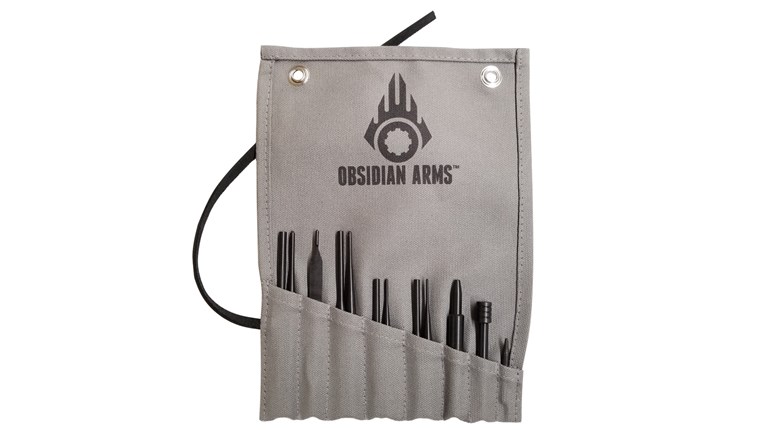
Cleaning and maintaining your guns preserves their functionality and value, and keeps them safe and accurate. The effort and attention you put into maintaining your firearms will pay off in peace of mind that your guns will do what you need them to do. Good maintenance habits help you know your gun better, and have more confidence in its performance at the range or in the field.
Preparation is key to a good job. Choose a work area that is well-ventilated, well-lit, organized and clean. Outdoors or in the garage is best. If you must work indoors, choose a large indoor room, and try to work near an open window. Your work table should be sturdy. It shouldn't rock or move when you lean on it. Avoid tables with wheels or casters. The dining room table or the kitchen counter is not the best choice, because you don't want to contaminate your food with chemical solvents, gun oil copper, lead or carbon fouling. For the same reason, you shouldn't eat or drink while you work.
Once you have chosen an appropriate work space, remove all ammunition from the area. All loose and boxed ammunition should be returned to its proper storage place before you start. Only after that is done should you get out your gun and make sure that it is clear. If the gun has extra magazines, make sure they are empty as well.
Before you get to work, find the owner's manual from the manufacturer. It should explain how to take the gun apart and clean it. Over the years, the manual for an older firearm, or one that was bought used, may have been lost. In that case, the two-volume NRA Guide to Firearms Assembly has written and visual instructions on taking apart a wide variety of rifles, shotguns and handguns.
There are a variety of specialized and improvised tools that will help you get the job done right, but can't be found in any cleaning kit. A rubber mat with a non-slip surface will help protect both the parts and the work bench from damage. A cleaning cradle keeps the gun under control and leaves your hands free to control loose parts and cleaning equipment. If you don't have one, a shooting rest for sighting-in or varmint shooting is better than nothing. Your bench vise may look tempting, but leave it alone: Too much pressure from the vise can crack the stock or even crush the receiver.
 Also, an old cookie tin or coffee can is useful for holding loose parts. A container helps keep them in one place so small parts won't get lost or separated. You might want two: one for dirty parts waiting to be cleaned, and a second for parts that have already been cleaned. Lastly, here's a trick for when springs or pins go flying: Keep a flashlight on hand, as it is often a big help in finding lost parts. Even the tiniest pins and springs that have fallen on the floor will cast a shadow when a beam of light passes over them.Once you have the gun disassembled, start with cleaning the bore. The rifling at the muzzle is critical to accuracy. You don't want the cleaning rod to bang against the muzzle opening. Over time, this can widen the muzzle opening or leave it misshapen, so clean from breech to muzzle whenever possible.
Also, an old cookie tin or coffee can is useful for holding loose parts. A container helps keep them in one place so small parts won't get lost or separated. You might want two: one for dirty parts waiting to be cleaned, and a second for parts that have already been cleaned. Lastly, here's a trick for when springs or pins go flying: Keep a flashlight on hand, as it is often a big help in finding lost parts. Even the tiniest pins and springs that have fallen on the floor will cast a shadow when a beam of light passes over them.Once you have the gun disassembled, start with cleaning the bore. The rifling at the muzzle is critical to accuracy. You don't want the cleaning rod to bang against the muzzle opening. Over time, this can widen the muzzle opening or leave it misshapen, so clean from breech to muzzle whenever possible.
With some guns the barrel is more or less permanently attached to the receiver, which leaves you with no choice but to clean the bore from the muzzle end. In that case use a bore guide (a sleeve that protects the muzzle), or a bore snake, rather than a rigid cleaning rod.
Use a cleaning rod of the correct diameter. They generally come in .22-cal., .30-cal. or shotgun/muzzleloader diameters. A cleaning rod that is too big will get stuck in the bore, while a cleaning rod that is too small will tend to flex in the bore and it will take too much effort to push it through. One clue is that bore brushes are sized to the diameter bore and will only thread onto a cleaning rod of the proper diameter.
Start with wet patches to loosen the fouling. Bore solvents are usually meant for either copper fouling or lead fouling. Naturally, if you have been shooting jacketed or copper-plated bullets, use a copper solvent. If you have been shooting unjacketed lead, choose a lead solvent. I prefer cotton patches because they are more absorbent than nylon patches. Spear the patch on a jag or thread it through a loop before you wet it with solvent. In my experience, jags produce better surface contact, but they can be harder to push through the bore. Try to push the patch all the way through the bore in one smooth motion. Don't scrub, change direction or pull the dirty patch back through the bore. Always remove the dirty patch from the rod when it exits the bore. After you've run three patches through the bore, it should be ready for the bore brush.
 Bore brushes should be matched to the diameter of the bore. They are available with nylon, bronze or steel bristles. Steel brushes are more rigid and abrasive and should be used with care and reserved for the toughest jobs. Nylon is the gentlest material, but it can take a lot more work to clean a bore with a nylon brush. In my experience, bronze brushes are the right choice for most cleaning jobs. Thread the brush to the cleaning rod and wet the bore brush with solvent. Once again, push the rod through in one smooth stroke and remove the brush after it exits the bore. Ten passes with the brush should be enough. Run three more wet patches through the bore to pick up the fouling loosened by the bore brush. Wipe down the cleaning rod before finishing up with dry patches. Each successive dry patch should come out of the bore cleaner than the last. If you don't see visible improvement after five to seven dry patches, repeat the process-starting with the wet patches-from the beginning.
Bore brushes should be matched to the diameter of the bore. They are available with nylon, bronze or steel bristles. Steel brushes are more rigid and abrasive and should be used with care and reserved for the toughest jobs. Nylon is the gentlest material, but it can take a lot more work to clean a bore with a nylon brush. In my experience, bronze brushes are the right choice for most cleaning jobs. Thread the brush to the cleaning rod and wet the bore brush with solvent. Once again, push the rod through in one smooth stroke and remove the brush after it exits the bore. Ten passes with the brush should be enough. Run three more wet patches through the bore to pick up the fouling loosened by the bore brush. Wipe down the cleaning rod before finishing up with dry patches. Each successive dry patch should come out of the bore cleaner than the last. If you don't see visible improvement after five to seven dry patches, repeat the process-starting with the wet patches-from the beginning.
Your next step depends on your shooting plans. Once you are satisfied that the bore is clean, you can leave the bore dry if you are going to shoot the same day. However, if you have to store the gun overnight or for a longer period of time, you will need to protect the bore from rust. Run a patch soaked with oil down the bore. Beware: Oil in the bore can create excessive pressure, a dangerous condition. Oil must be swabbed out before you shoot again, so get in the habit of running a dry patch down the bore before you take your gun to the range or the field.
Old toothbrushes, rags and cotton swabs are all useful aids for cleaning the rest of the gun. A general-purpose cleaner like Break Free or a carbon solvent will help loosen built-up powder fouling in the action. Once you are happy with your work, reassemble the gun right away. The longer the gun is left disassembled, the greater the chance parts will be lost or broken.
After you have reassembled the gun, it's time to make sure all of the parts work properly. Check the safety and the trigger for proper function. When you are satisfied that everything is in working order, you should oil down the exterior metal surfaces of the gun, because sweat and body oil from your hands can activate rust. Don't overdo it; a light coating of oil is enough. Be aware that gun oil can soften the wood, so don't soak the joints between the action and the stock.
Cleaning your guns is part of responsible and safe gun handling. Clean firearms are safer, more accurate and more reliable. The better you know your gun, the better you can diagnose accuracy and function problems, which makes you more confident at the range and in the field.







































